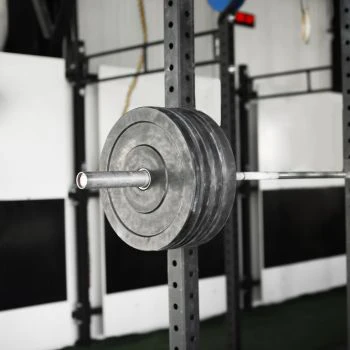As a fitness trainer with over eight years of experience, I've used both a full and a half squat rack, and I can attest that there are some differences between the two, especially the types of exercise performed on them.
I went through a vast amount of research and chatted with my fellow gym trainers to give a more elaborate and precise distinction between the two.
Let's dive in.
Quick Summary
- For effective strength training, a full rack offers more exercise variety and safety features, while a half rack saves space and is cost-effective.
- Half racks are adequate for basic compound motions such as squat stand, bench press, and overhead press, while a full power rack can become a completely functional gym station.
- Studies from sources like PubMed and the National Library of Medicine highlight the versatility of full racks for both lower and upper-body workouts.
- I find full racks to be a better investment for serious lifters due to their safety and versatility, despite their larger size and higher cost.
Full Rack vs. Half Rack: Overview

Full rack
Regarding gym equipment, power racks, often known as "full power racks" or "squat stand cages," are the gold standard.
There are several reasons why a full rack is an ideal choice in any power rack guide.
These squat racks contain four vertical supports (up to six in some instances) fastened to a firm (metal) base and top.
The J-hooks guarantee a handy variable-height rack to rest your barbell on.
The two adjustable "safety catchers" (horizontal supports) running down the rack's sides offer a fail-safe if you drop the load or lose your balance.
The full power rack was a game-changer in my home gym. Its adaptability allowed me to explore a variety of workouts, despite the space it occupies.
It's designed to survive for years of consistent usage.
According to PubMed and National Library of Medicine studies, it offers various lower and upper body exercises, such as:
- Deadlifts [1]
- Chin-ups
- Squat stand [2]
- Hanging leg raises
- Overhead presses [3]
- Rack pulls
- Barbell lunges
"There is little doubt that, while a half rack may be made safer in various ways, a full rack is intrinsically safe. It's an excellent option for rookie lifters who don't know how to squat stand and may compromise their posture and have let unpredictably go of the bar."
- David Kiesling, Doctor of Medicine
Half Rack

As the name implies, a half-rack is half of a power rack.
Using a half-rack with just two posts, I found it to be a space-efficient solution, ideal for my smaller workout area.
These posts will usually be attached to a sturdy foundation, but there will be no top.
The half-rack, like the full rack, features adjustable J-cups and bars that let you alter the height of the bar, in addition to two horizontal "safety catchers" that act as a fail-safe if you slip or lose control of the weight.
"Consider a squat rack a smaller version of a full rack. A squat rack may be modified and is an excellent first investment if capacity and money are constraints."
- Olivier Poirier, Fitness Trainer
Recommended Full Rack Exercises

Any weight bench may be fitted within a quality power rack, increasing the variety of workouts in your home gym. However, this does not indicate that this fitness equipment is inevitably the winner.
Using my full rack, I've been able to perform a diverse range of exercises, from squats to pull-ups, all in one station.
The usual guideline is that if you can do it at a gym with a spotter, you can do it at home with a power rack.
Recommended Half Rack Exercises
Because a half rack appears smaller than a power rack, it cannot accommodate as many workouts.
This is a critical reason for supporting power racks in the half-rack vs. full-rack discussion.
A half rack can support:
- Weighted lunges
- Squats
- Chest presses
- Bench presses [4]
Some half racks contain barbell supports; however, not all of them. In certain circumstances, these supports are available as an optional extra that you must pay for.
Full Rack vs Half Rack: Pros and Cons
Full Rack Pros and Cons
Even though it's an incredible piece of equipment, a full squat rack has pros and cons. Let's look at them closely.
- More training variety - a power rack allows you to perform considerably more workouts
- A power rack serves as a human spotter
- Lifting weights when inside one is safe
- These items of exercise equipment are highly durable and of excellent quality
- A full squat rack takes up a lot of room in a home gym
- If there is insufficient clearance, the top bars of the full rack may cause damage to your walls
- Your available workout space may be limited
Half Rack Pros and Cons
The half squat rack suits both powerlifters and newbies but has its pros and cons.
- In the home gym, a half rack takes up less room
- They are less costly
- When it pertains to barbell exercises, you have greater leeway
- You can workout more readily outside of the half rack
- They are occasionally composed of a less durable metal than power racks
- A half-squat rack can only be used for a limited amount of workouts
- There are no protection bars; however, they may be available separately
Half Rack Vs Full Rack: Differences

Here we distinguish the two types of equipment and why they are the better option for you.
1. Width and Size
I noticed the full rack's size can be a challenge, but its benefits in my training routine made it worth the space.
A full rack is frequently broader and longer, taking up more floor area. It could also be taller (though this may vary with the model type).
While this is never an issue for someone with a big backyard, cellar, or garage to turn into a gym, it is a significant worry for home weight trainers with limited space.
Full-size power racks are typically 4 feet wide, 4 plus feet long, and 7-8 feet tall.
They might not fit on a low-ceilinged floor, and they're certainly not the type of equipment you'd want to have lying around in your sitting room or office corner. They require a separate training area.
2. Cost

Given the names—half rack vs. full rack—you'd expect the half rack would be half the price.
A half rack may cost 60-70% of a full rack.
And you're still receiving a well-made, durable metal piece of machinery, but it's a little less expensive.
In terms of value, a full rack is nearly always a superior alternative if you have the room.
3. Weight
Note that the squat rack is solid metal (usually stainless steel); therefore, it will be hefty.
A full-sized power rack may weigh roughly 200 pounds but can weigh up to 350 pounds or more.
When I installed my full rack, its weight of 200 pounds added a sense of sturdiness to my workouts.
Heavier squat racks are more robust and last longer, although there are also types that employ lighter materials (such as aircraft-grade aluminum rather than steel) that are still quite sturdy.
You can't only worry about the rack; you also need to consider your weight and the barbell's load.
That's a lot of weight in one area if you're a 200-pound weightlifter squatting an Olympic barbell filled with 200 pounds.
You might do major damage to the floor if you are not on solid concrete (which is why most people turn their basements or garages into a gym since they can handle the weight).
A half rack carries somewhat less weight. Because there are just two vertical pillars and the base, the rack will be around half the weight of a power rack.
They're a better option if you search for machinery that can be used on less-solid floors (like your patio/deck or an upstairs room).
4. Stability

This is the most important distinction that drives many consumers to choose the heavier, more expensive, bigger full rack over a half rack.
Despite its lighter build, my half rack proved stable enough for most of my weightlifting sessions.
You may rack the barbell with confidence that it will not tilt, shake, or fall over—they are engineered to provide weight stability.
The problem only occurs when you attempt to perform exercises like pull-ups, hanging leg lifts, chin-ups, or kip-ups utilizing the upper bar/built-in pull-up bar.
It's simple physics: your weight can weaken the base because you're so far up. You'll notice the half-rack shifts/wobbles when performing these movements.
5. Ease Of Use
In my experience, both full and half racks are user-friendly, but I particularly enjoyed the ease of lifting with the half rack.
Half racks are smaller, making it more challenging to maneuver around them, although both half racks and full power racks are simple to operate.
6. Maintenance & Repair

If you choose a high-quality model, full and half racks are simple to maintain.
To clean your home gym equipment, wash them down with a moist towel and inspect them once every month to ensure no damage.
Because half racks are meant to hold less weight, there is a little greater danger of breakage from overloading it; however, this is extremely unlikely if appropriately used.
In terms of maintenance, there is no discernible distinction between the two kinds of squat racks.
7. Durability
A decent-quality weight rack, whether half or full, will be sturdy and should withstand heavy use.
The construction quality and brand will influence the rack's lifespan.
Due to the way they are made, full racks have a stronger body, which means they may endure for years even if they are heavily used. On the other hand, half racks are less resilient and will not last as long.
With a power rack, four (or six) sturdy supports, and a top and base that lock the "cage" form securely, you'll never tilt or wobble a millimeter, regardless of how hard you are swinging on the top pull-up bar.
These are the distinctions between the two; otherwise, they are almost similar in every aspect that counts.
You can complete the same number of workouts on a half rack or even a full rack, and they're still intended to support your weight and provide a fail-safe (the "safety arms") if you fall or lose the weight.
Full racks and half racks are excellent to utilize in your home gym— it's a matter of determining which best matches your needs.
8. Key Safety Features
Both full and half racks are designed with safety in mind. Full racks often come with safety bars or straps that catch the barbell if you fail a lift, especially during squats or bench presses.
Half racks, while more open, may have optional safety arms that can be attached. It's important to understand and utilize these features effectively.
Related Articles:
FAQs
What Is the Purpose of a Half Rack?
The purpose of a half rack is to function as a spotter, allowing you to lift weights safely. It is also a sturdy platform for several workouts like bench press, squat stand, and pull-ups.
Should You Bolt Down a Half Rack?
Yes, you should bolt down a half rack, as squat racks should always be fastened before usage. If it can't be bolted down, ensure the rack is heavily weighted and has a broad base for stability.
What Do You Put Under a Power Rack?
You put an interlocking mat under a power rack, which can be either high-density EVA foam or rubber.
References:
- https://pubmed.ncbi.nlm.nih.gov/26840440
- https://www.ncbi.nlm.nih.gov/pmc/articles/PMC6050697/
- https://www.ncbi.nlm.nih.gov/pmc/articles/PMC9354811/
- https://pubmed.ncbi.nlm.nih.gov/31567719/
Injury Prevention
These are the best practices for injury prevention:
- Proper setup: Ensure that the rack is assembled correctly and all components are securely fastened. Regularly check for any loose parts.
- Use safety bars: Always adjust the safety bars or arms to the appropriate height for your exercises. They should be set at a level where they can catch the barbell in case you can't complete a lift.
- Correct lifting Technique: Maintain proper form during exercises. This not only improves effectiveness but also minimizes the risk of injury.
- Avoid overloading: Do not load the barbell with more weight than you can handle or more than what your rack is rated for.
Rack Accessories and Enhancements
Full and half racks can be significantly enhanced with a variety of accessories, turning them into versatile workout stations. These add-ons not only save space but also add to the functionality, allowing for a more comprehensive workout routine.
Popular rack accessories:
- Dip bars: Attachable dip bars can be a great addition for upper body workouts, targeting triceps, chest, and shoulder muscles.
- Pull-up bars: Many racks come with integrated pull-up bars, but there are also advanced options available, like multi-grip bars, which allow for a variety of pull-up styles.
- Band hooks: Adding band hooks to your rack can introduce resistance band exercises, offering a different dimension to your strength training.
- Plate storage: To keep your workout area tidy, add plate storage pegs to your rack. This not only saves space but also adds stability to the rack.
- Landmine attachments: These allow for a range of rotational exercises, targeting different muscle groups and adding variety to your workout.
About The Author
You May Also Like






